In a very similar way as I did here for MVC, the Helsinki UI/BL/DL code classes can be mapped across the client, middle and data tiers too:
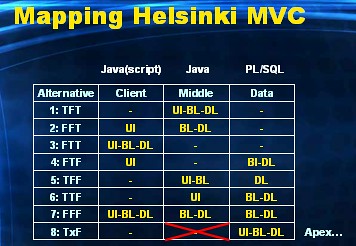
What I do differently here compared to the earlier display of MVC mapping across the tiers, is that whenever the M is distributed across two tiers, I divide the M into BL and DL. The guideline of how to split up the M, is now made explicit: we divide it into BL and DL. Btw. this only happens in option 5.
- 1 TFT: UI, BL and DL all go into the middle tier.
- 2 FFT: UI goes into the client tier, BL+DL go into the middle tier.
- 3 FTT: All go into the client tier.
- 4 FTF: BL+DL go into the data tier. UI into the client tier.
- 5 TFF: DL goes into the data tier. Rest in the middle tier.
- 6 TTF: BL+DL go into the data tier, and UI in the middle tier.
- 7 FFF: BL and DL in every tier.
- 8 TxF: Low and behold! A new option. With Apex (Oracle Application Express) we can push UI into the DBMS. So all goes into the DBMS. The lowercase x denotes the absent mid tier in this scenario.
In the Helsinki declaration we only allow the options that have BL and DL in the data tier: option 4 (if you require a fat, responsive client program), option 6 (html-frontend + you really want to do some Java) and 8 (html-frontend + all you have is PL/SQL knowledge).
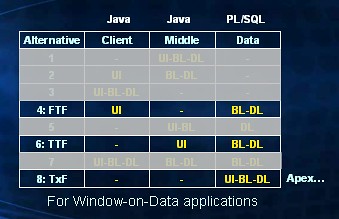
All other options have some object-oriented design as the foundation of the WoD application. Which is just plain wrong, and therefore prohibited by the Helsinki declaration. I discussed that here: BL and DL just do not benefit from object orientation: WoD applications work best when they sit on top of a relational database design.
Going back to the picture I've shown you before:

What this means is that we map the DBMS like this:
During the presentation I then mention that inside the Java realm only two classes should be allowed: a Row class and a TableOfRows class. In Helsinki, Java is used only to generate UI: it receives the row or table-of-rows to be displayed from the DBMS. All it needs to do is display the data in a user friendly way. Needless to say that this approach completely and utterly disarms the Java developer(s). Your relationship with them turns into a love/hate relationship:
- They'll love you because you make their job infinitely more easy.
- They'll hate you because their billable-hours go down the drain.
Advantages of the Helsinki approach
It should not suprise you that this approach completely turns around the main two disadvantages I mentioned earlier when building WoD applications in a mid-tier centric way. Designing and programming a WoD application in the Helsinki way, will greatly reduce the number of roundtrips to the DBMS.
I cannot repeat this enough: if the database design fits your WoD application needs, the Helsinki approach will always outperform any other architecture. Adversaries often bring up the argument, that by pushing 'application logic' (which they never clearly define) into the DBMS layer, that layer will immediately become the bottleneck. I have two responses to this argument.
- You will actually put more stress on the DBMS in a mid-tier centric approach. I gave you the example of 70,000 calls to display twenty customers on a page. I know it was an extreme case. But decrease that to 700 calls: I'm willing to bet one monthly salary that that still causes more CPU cycles to be spent inside the data tier compared to an Helsinki approach. Even the other example I gave (GrandParent, Parent, Child report) which calls the DBMS in the order of 50 times causes more activity inside the DBMS that would have been necessary in a Helsinki approach.
- By far the majority of the WoD applications built today, will run just smoothly on todays powerful SMP servers. The percentage of (Helsinki) WoD application deployments that will cause the DBMS to become the bottleneck is very, very small. And, being an Oaktable member, I probably should not say this, but one can always consider clustering the DBMS tier (Oracle RAC) to provide more CPU power in that tier.
I have experienced this first-hand. One of my customers had built a WoD application around 2002 in a database-centric Helsinki manner. They used the then hot JDeveloper release with its accompanying MVC frameworks: UIX, BC4J and Struts. Two years ago they were faced with a long overdue upgrade of the JEE technology stack: upgrade to newest release of application server, and newest release of JDeveloper with its current versions of the accompanying MVC frameworks. After having spent six months trying to get this done, it was decided to just rebuild all pages in Application Express (the now sexy du-jour UI-technology). Since no DL and BL logic sat outside the data tier, this was achieved in just over two months by four people, without any change in all BL and DL code that sat inside the DBMS.
I think that could be called agile, not?
A collegue of mine back then coined the phrase: UI-code is throw-away code. I could not agree more. It is the top of the technology stack where all the volatility sits, and continuous change happens. Use it thinly and you get agility.
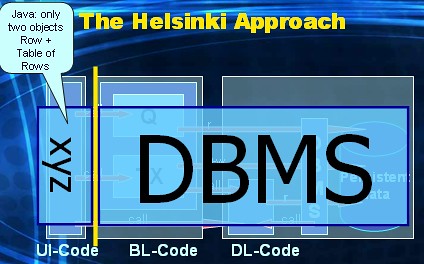
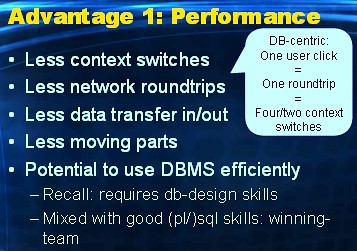
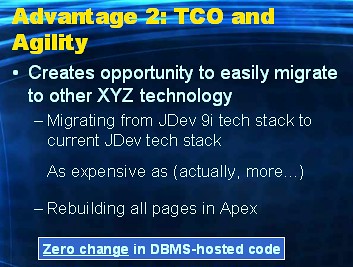
Thanks Toon!
ReplyDeleteI've been following THD for a while nad it resonates extremely to what we DBA's see. Keep it up mate!
Cheers,
Alex
Nice Blog.
ReplyDeleteWeb Application Development Services
Application Development Consulting Services